In the Moment:
Michael Frye's Landscape Photography Blog
by Michael Frye | Apr 6, 2012 | Digital Darkroom
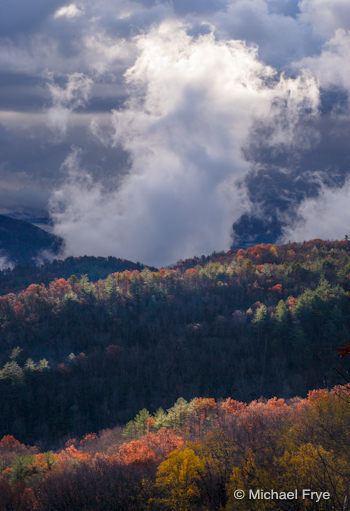
Clearing storm along the North Carolina-South Carolina border—processed with Lightroom 4
I’ve finally had a chance to really dive into Lightroom 4, and I’m very happy with the results I’ve been getting. While I haven’t found a big difference in processing low-contrast images, with high-contrast scenes the improvements are significant.
The accompanying image was made during my trip to South Carolina last November. It was a fast-changing situation—the sun suddenly broke through, and I missed the exposure slightly, so the brightest highlights at the top of the clouds were blown out. By the time I adjusted the exposure the scene had changed.
(more…)
by Michael Frye | Apr 2, 2012 | Yosemite Photo Conditions
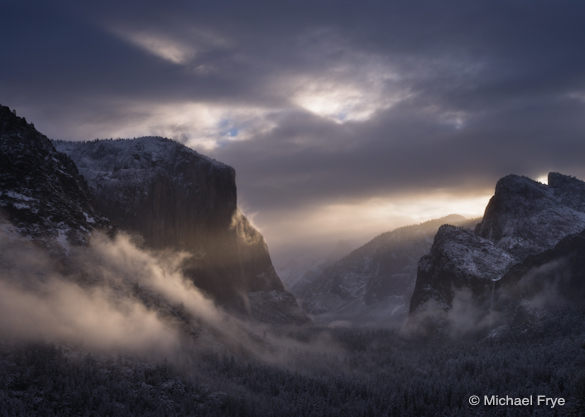
Sunbeams striking El Capitan, 6:32 a.m. Sunday
Winter arrived late in Yosemite this year, but now it seems reluctant to leave. Of course that’s fine with me, as I love photographing storms, and we certainly need the moisture.
A short but intense weather system dropped about an inch of precipitation on Yosemite Valley Saturday afternoon and evening. The storm began with rain, but quickly changed to snow. I was in the valley on Saturday for the Yosemite Conservancy Spring Forum, and driving out at about 5:30 in the afternoon I encountered blizzard conditions, with thick snow blowing sideways. I stopped at El Capitan Meadow and set up my camera and tripod underneath the back hatch of my car to try and capture the falling snow (see the photograph below). I managed to keep the camera dry, but my pants were soon coated with an inch of snow.
It looked like we might see clearing on Sunday morning, so Claudia and I drove up early and joined about ten other people at Tunnel View. We started talking and socializing, but all that stopped when some breaks appeared in the clouds, and then rays of sun struck El Capitan (above).
(more…)
by Michael Frye | Mar 29, 2012 | Light and Weather, Photography Tips
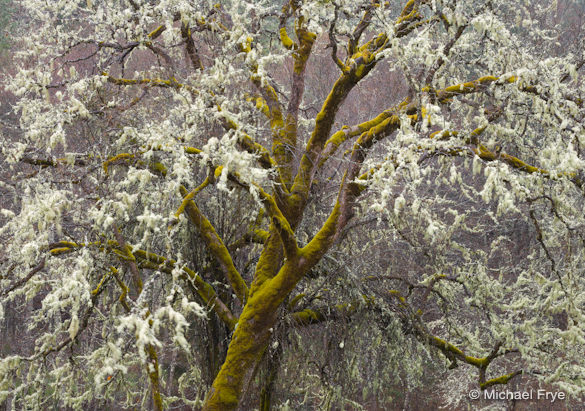
Mossy oak in the rain
Claudia and I are in Humboldt County this week visiting our son Kevin, who’s a junior at Humboldt State University. This is redwood country, along the far northern coast of California. It’s a temperate rain forest, and it sure seems like it this week. It’s been raining—a lot. Yesterday we had a break, and a mostly rain-free day, but another storm arrived today, and the area is expected to get six to ten inches of rain over the next two days.
Although we’re mainly here to visit our son, of course I hoped to do some photography in this beautiful area as well. The main challenge of photographing in the rain is keeping the camera dry. I’ve tried many different ways of doing this: umbrellas, towels, plastic bags, etc, but there’s no perfect solution. Various people make rain covers for cameras, which work pretty well, but only for telephoto lenses. In fact it’s a lot easier to photograph with long lenses in the rain, regardless of what kind of cover you put over the camera, because you can use a long lens hood to keep rain off the front glass. Hoods for wide-angle lenses have to be short, to avoid vignetting, which makes it difficult to keep water from splashing onto the front element. The best solution I’ve found for wide-angle lenses is to attach an umbrella to my tripod with a clamp. This works, but it’s awkward.
(more…)
by Michael Frye | Mar 23, 2012 | Yosemite Photo Conditions
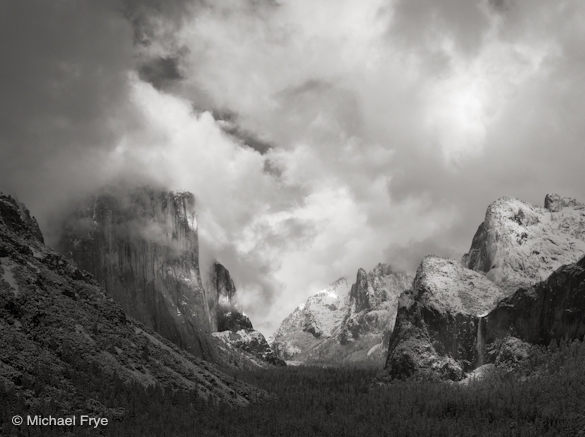
Clearing storm from Tunnel View, 5:03 p.m. last Sunday.
The storm last weekend in Yosemite was a big one: almost four inches of liquid (rain and snow) fell in Yosemite Valley, and Badger Pass, at 7200 feet, got four feet of new snow. Of course one storm, even a large one, isn’t enough to make up for the months of dry weather preceding it; Yosemite has now received about 67% of average precipitation since last July. But the waterfalls got a noticeable boost, there’s a decent snowpack in the high country, and conditions seem more normal—more like a typical March.
Last Saturday night about seven inches of snow fell at my house in Mariposa. At daybreak on Sunday the skies were overcast, but it had stopped snowing, and I decided to try light-painting the beautiful manzanita bush outside my office. I hope the warm lighting in this photograph (below) looks pretty natural, like early-morning sunlight, but it was actually created well before sunrise with a flashlight.
(more…)
by Michael Frye | Mar 16, 2012 | Yosemite Photo Conditions
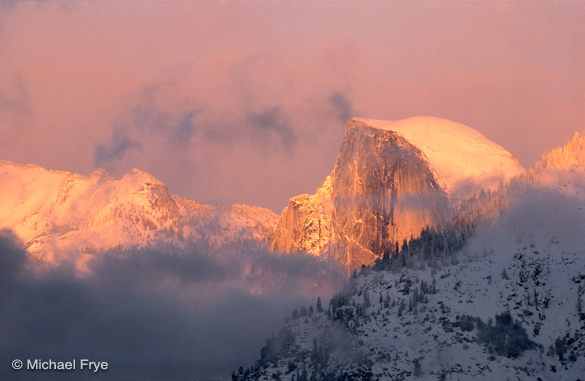
Half Dome, winter sunset — from 1989 (!)
Rain reached northern California this week, but Yosemite only got brushed by the southern edge of these storms. That’s about to change, however, if the forecasts are right. The National Weather Service issued a winter storm warning for Yosemite and the southern Sierra Nevada for tonight and tomorrow, with two to three feet of snow possible above 6000 feet. The heaviest precipitation will fall as rain in Yosemite Valley (at 4000 feet), but as a cold front moves through on Saturday afternoon snow levels are expected to drop down to 2000 feet. Even though the main part of the storm will have passed by that time, forecasters are predicting plenty of showers Saturday night and Sunday, and significant amounts of snow could accumulate in Yosemite Valley and the Sierra foothills.
(more…)
by Michael Frye | Mar 9, 2012 | Photography Tips, Vision and Creativity
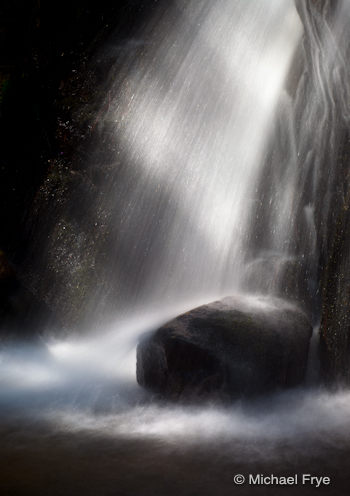
Small waterfall in Yosemite Valley, high noon
Everyone develops routines and habits: waking up at the same time every day, eating the same thing for breakfast, taking the same route to work… and on and on. Routines are beneficial in some ways—they help us avoid spending time and energy making small, unimportant decisions every day.
In photography, routines can help with the technical, left-brained stuff. Always putting lens caps in the same place in your camera bag, or the same pants pocket, can help save time and avoid frustration. Checking off a mental list before pressing the shutter can prevent mistakes. Did you adjust the polarizer? Focus? Set the right aperture? Shutter speed? Did you check the histogram? What’s your ISO?
But routines also dull the senses, and in photography that can be deadly. I’ve photographed this small waterfall in Yosemite many times, but always in the shade. Soft light works well for subjects like this—it makes it easy to use slow shutter speeds, and simplifies the lighting. So I’d never even considered visiting this spot when sunlight was hitting the water.
Last weekend I was shooting footage for some instructional videos in Yosemite Valley. I wanted to talk about using slow shutter speeds with moving water, but the crew only had one day in Yosemite, and the schedule only allowed us to visit this waterfall at noon. As we approached the fall I thought, hmm, this might work. Backlight filtering through the trees created some interesting patterns, and as the sun moved it started to highlight just the right spots. As I was demonstrating how different shutter speeds affected the appearance of the water, I was looking at the images on my viewfinder and thinking, “Wow, that looks pretty cool!”
(more…)
by Michael Frye | Mar 7, 2012 | Announcements, Digital Darkroom
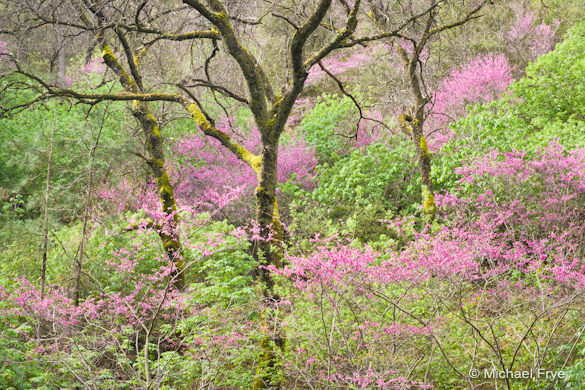
Redbud and oaks, Merced River Canyon, processed in Lightroom 3
If you’re a regular reader of this blog you know that I’m a big fan of Lightroom. It’s easy to use, yet powerful, which makes it a great tool for both beginning and advanced photographers. I teach workshops about Lightroom, and wrote an eBook about it, because I think it’s a tool that can help many photographers. Personally, as Lightroom’s processing tools have grown more sophisticated I’ve used Lightroom more and more and Photoshop less and less.
As many of you probably know, Lightroom 4 went on sale yesterday. In this new version Adobe has completely revamped the Basic panel, with significant improvements in highlight and shadow recovery. I’ve already used the beta version of Lightroom 4 to take advantage of those improvements. For example, I was able to get smoother transitions around the sun in one of the photographs from this post (“Ross’s geese taking flight at sunset”).
The Basic panel tools have completely changed in both operation and behavior, which may require some modifications in they way we work in Lightroom. I’m looking forward to exploring these new tools, and telling you about my discoveries, but unfortunately I’ve encountered a frustrating roadblock—a bug in Lightroom 4 that causes all of my Tone Curve settings for images previously processed in Lightroom 3 to disappear! All I see is the default Tone Curve for the camera, and, since I do most of the tonal adjustments for every image with curves, my images look rather flat (the accompanying images show one example of this). And I don’t want to re-create the curve for thousands of images!
(more…)
by Michael Frye | Feb 29, 2012 | Yosemite Photo Conditions
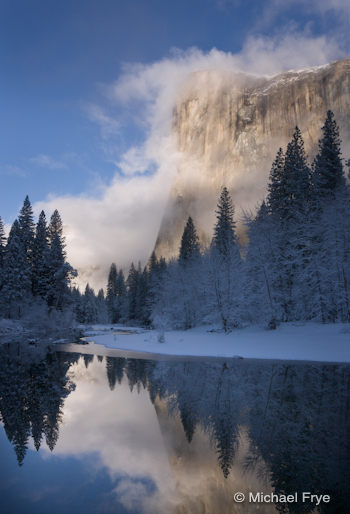
El Capitan and the Merced River, February 15th
Earlier in the week forecasters weren’t expecting much precipitation out of the storm that’s arriving now in the Sierra, but the National Weather Service is now predicting up to a foot of snow in Yosemite Valley, and they’ve issued a winter storm warning for today and tonight. A foot of snow will make driving and walking in Yosemite Valley difficult, but it should be beautiful when it clears.
The two accompanying photographs are from the morning of February 15th. About four inches of snow fell the night before, and the storm cleared just before sunrise, creating perfect conditions. If you were to rank Yosemite sunrises on a scale of one to ten for their photographic potential, this one was a ten. Were any of you there that morning?
The current storm may revive Horsetail Fall, but the window of best light has passed. The light on Horsetail can still be beautiful in early March, but the color, at best, will be gold, not orange or red. I don’t expect this one storm will cause a sudden gushing either, but it should create some flow.
—Michael Frye
Related Posts: Quick Horsetail Update; Horsetail Dries Up!
Michael Frye is a professional photographer specializing in landscapes and nature. He is the author and photographer of The Photographer’s Guide to Yosemite, Yosemite Meditations, and Digital Landscape Photography: In the Footsteps of Ansel Adams and the Great Masters, plus the eBook Light & Land: Landscapes in the Digital Darkroom. He has written numerous magazine articles on the art and technique of photography, and his images have been published in over thirty countries around the world. Michael has lived either in or near Yosemite National Park since 1983, currently residing just outside the park in Mariposa, California
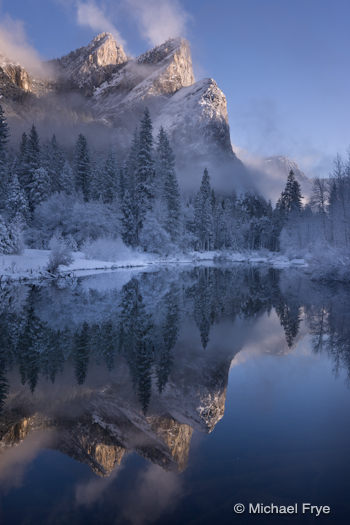
Three Brothers and the Merced River, February 15th
by Michael Frye | Feb 25, 2012 | Yosemite Photo Conditions
On Thursday evening there was enough water to give Horsetail Fall a nice glow at sunset. Last night there wasn’t. Apparently nearly all the snow has melted on top of El Capitan, and it looks like the show is over for this year. Just wanted to let you all know in case you have plans to photograph it this weekend.
Bummer! Hope some of you got some nice images while it lasted.
—Michael Frye
by Michael Frye | Feb 22, 2012 | Announcements
In case you didn’t catch this yet, I was interviewed about Horsetail Fall for NPR’s All Things Considered yesterday. You can listen to the piece here. All I can say is that they did a good job of editing this! It was a lot of fun and quite an honor to be on this premier radio program.
—Michael Frye

















